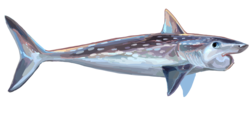| Helicoprionidae Temporal range: Early Carboniferous to Late Permian | |
|---|---|
 | |
| Helicoprion | |
| Scientific classification | |
| Kingdom: | Animalia |
| Phylum: | Chordata |
| Class: | Chondrichthyes |
| Order: | † Eugeneodontiformes |
| Clade: | † Edestoidea |
| Family: | † Helicoprionidae Karpinsky, 1911 |
| Type genus | |
| Helicoprion Karpinsky, 1899 [1] | |
| Type species | |
| Helicoprion bessonowi Karpinsky, 1899 | |
| Genera [2] | |
| Synonyms | |
| |
Helicoprionidae (sometimes referred to as Agassizodontidae) [3] is an extinct family of holocephalans within the order Eugeneodontida. Members of the Helicoprionidae possessed a "whorl" of tooth crowns connected by a single root along the midline of the lower jaw. [3] [4] While historically considered elasmobranchs related sharks and rays, [3] the closest living relatives of the Helicoprionidae and all other eugeneodonts are now thought to be the ratfishes. [5] The anatomy of the tooth-whorls vary between taxa, with some possessing highly specialized, coiling spirals (such as those of the namesake genus Helicoprion ), while others such as Sarcoprion and Parahelicoprion possessed shorter whorls. [3]






